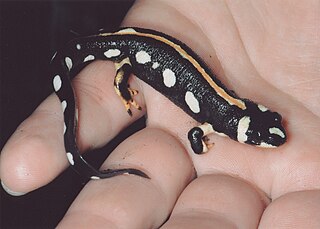
The fire belly newt or fire newt is a genus (Cynops) of newts native to Japan and China. All of the species show bright yellow or red bellies, but this feature is not unique to this genus. Their skin contains a toxin that can be harmful if ingested.

Neurergus is a genus of salamanders, more specifically newts, in the family Salamandridae. They are found in the Middle East, and are kept and bred in captivity for their bright colors. In nature, they inhabit streams and small rivers, and the surrounding forests or shrublands. All of the Neurergus are considered threatened species, primarily due to destruction of habitat and overcollection for the pet trade.
Brachycormus is an extinct genus of salamandrid amphibian from the Oligocene–Miocene of Europe.
Batrachosuchoides is an extinct genus of prehistoric amphibian from the Early Triassic of Russia. It was found in the Baskunchakskaia Series and the Lestanshorskaya Svita.
Batrachosaurus is an extinct genus of prehistoric brachyopoid amphibian that lived in Germany during the Middle Triassic (Ladinian). The genus was named by Joseph Fitzinger in 1837 and the type species, B. jaegeri, was named three years later in 1840. It may have been the same animal as Mastodonsaurus.

Chelotriton is an extinct genus of prehistoric salamanders that lived in Europe and Central Asia during the Neogene. It closely resembles the extant genera Tylototriton and Echinotriton.
Deltacephalus is an extinct genus of prehistoric stereospondyl temnospondyl from Madagascar.
Inflectosuchus is an extinct genus of prehistoric amphibian.
Indolyrocephalus is an extinct genus of prehistoric amphibian.
Notobrachyops is a genus of brachyopid temnospondyl amphibian. It is known from a skull roof impression found in the Ashfield Shale of Mortdale, New South Wales, Australia. The Ashfield Shale has also yielded a shark species, a lungfish species, six species of paleoniscid fish, a species of holostean fish, a subholostean fish, and the labyrinthodont amphibian Paracyclotosaurus davidi.
Kestrosaurus, occasionally misspelt as Kerstisaurus, is an extinct genus of Triassic capitosauroid temnospondyl amphibian within the family Mastodonsauridae.
Rewana is an extinct genus of prehistoric temnospondyls. Two species have been described from the Arcadia Formation of Australia.
Procochleosaurus is an extinct genus of cochleosaurid temnospondyl. Known from the Jarrow coal mines of Ireland, this genus is the oldest known member of the family Cochleosauridae. It was quite similar to Cochleosaurus, an early temnospondyl from the Czech Republic.
Plagiorophus is an extinct genus of prehistoric plagiosaurid. It is known from the Middle Triassic Bukobay Formation (Ladinian) and Donguz Formation (Anisian) of Russia.
Peltostega is an extinct genus of prehistoric trematosaurians. The type is the only known species, Peltostega erici It is known from the Early Triassic Kongressfjellet Formation of Svalbard and Jan Mayen.
Schoenfelderpeton is an extinct genus of prehistoric amphibian. It is a sister taxon to Leptorophus tener.

Ichthyosaura is a genus of newts in the family Salamandridae, found in Europe. It contains one extant species: the alpine newt. One fossil species from the Miocene, Ichthyosaura randeckensis, has also been referred to this genus, although this has been challenged.

Poisonous amphibians are amphibians that produce toxins to defend themselves from predators.
Ichthyosaura randeckensis is a fossil newt species in the family Salamandridae. It was described in 2013 from a Miocene volcanic lake deposit, the Randeck Maar Formation, in Germany. The fossil specimen is fully articulated and 3–4 centimetres (1.2–1.6 in) long. A phylogenetic analysis found the species to be the sister species of the extant alpine newt, and the authors therefore placed it in the same genus. Later analysis by other authors did not confirm this, however; they suggested I. randeckensis may not belong to Ichthyosaura.




